Wednesday 22 February, 2006, 11:57 - Spectrum Management
Looking through the statistics which highlight the phrases people have typed into various search engines in order to find this site showed that several people had found it by typing the words "bandwidth of stereo fm broadcast". However, this isn't something that's really discussed in detail so the time has come to rectify that situation.First off, the bandwidth of an amplitude modulated (AM) signal is really easy to calculate. Modulating a radio frequency (RF) carrier with an audio frequency (AF) signal which has a highest audio frequency at B kHz produces a radio signal with a bandwidth of 2B kHz (i.e. twice the highest audio frequency). There are a number of variants of AM including DSB (double side-band) and DSB-SC (double side-band supressed carrier) and even ISB (independent side-band), however these all occupy the same bandwidth. All sorts of clever filtering can be applied to an AM signal to make it occupy less bandwith producing modulation schemes such as SSB (single side-band), VSB (vestigal side-band).
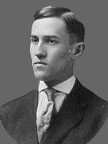
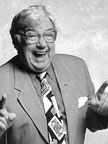 Calculating the bandwidth of a frequency modulated (FM) signal is a lot more complicated, however we should be eternally grateful for Carson's Rule, developed not by Northern Irish comedian Frank Carson but by American mathematician John Renshaw Carson. Carson did a lot of number-crunching to simplify things for us. His rule is this: If an RF carrier is frequency modulated with an AF signal which has a highest audio frequecy of B kHz with a deviation of D kHz, 99% of the resulting signal is contained in a radio bandwidth of 2(B+D) kHz. Deviation is the maximum distance that the signal moves from its centre frequency, so if our centre frequency is 5 MHz and this goes up to 5.05 MHz (and equally down to 4.95 MHz) when we apply the modulation, the deviation is 0.05 MHz or 50 kHz.
Calculating the bandwidth of a frequency modulated (FM) signal is a lot more complicated, however we should be eternally grateful for Carson's Rule, developed not by Northern Irish comedian Frank Carson but by American mathematician John Renshaw Carson. Carson did a lot of number-crunching to simplify things for us. His rule is this: If an RF carrier is frequency modulated with an AF signal which has a highest audio frequecy of B kHz with a deviation of D kHz, 99% of the resulting signal is contained in a radio bandwidth of 2(B+D) kHz. Deviation is the maximum distance that the signal moves from its centre frequency, so if our centre frequency is 5 MHz and this goes up to 5.05 MHz (and equally down to 4.95 MHz) when we apply the modulation, the deviation is 0.05 MHz or 50 kHz.Applying this practically, a mono FM broadcast has a highest audio frequency of 15 kHz and a deviation of 75 kHz, so the resulting FM signal has a bandwidth of 2*(15+75)=180 kHz. For stereo the audio bandwidth increases to 53 kHz (see this article) and so the resulting FM signal has a bandwidth of 2*(53+75)=256 kHz. For a CB radio the highest audio frequency is usually 3 kHz and the deviation just 2 kHz resulting an RF bandwidth of 2*(3+2)=10 kHz - which is why CB radio channels are spaced 10 kHz apart! See, there a reason for everything.
add comment
( 3718 views )
| permalink
| 



 ( 2.8 / 12724 )
( 2.8 / 12724 )




 ( 2.8 / 12724 )
( 2.8 / 12724 )
Tuesday 21 February, 2006, 14:26 - Amateur Radio
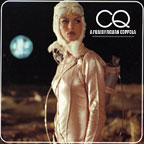 As a Valetine's Day gift to the UK Radio Amateur community, Ofcom has decided to modify its radio amateur licensing policy. From 1 October 2006, instead of having to renew licences annually (at a price of GBP15 per annum), a lifetime licence will be issued. This licence will remain valid until either it is revoked by Ofcom, surrendered by the licensee or the details (such as the station address) become invalid (at which point a new licence will be issued). Licences, however, will need to be revalidated every 5 years. And the cost for this marvellous new licence - amazingly enough - nothing! It will be free. Well, it will be free if licensees use the proposed on-line licensing facility. If you prefer a paper-based licence, a small administrative fee will be charged.
As a Valetine's Day gift to the UK Radio Amateur community, Ofcom has decided to modify its radio amateur licensing policy. From 1 October 2006, instead of having to renew licences annually (at a price of GBP15 per annum), a lifetime licence will be issued. This licence will remain valid until either it is revoked by Ofcom, surrendered by the licensee or the details (such as the station address) become invalid (at which point a new licence will be issued). Licences, however, will need to be revalidated every 5 years. And the cost for this marvellous new licence - amazingly enough - nothing! It will be free. Well, it will be free if licensees use the proposed on-line licensing facility. If you prefer a paper-based licence, a small administrative fee will be charged. However in the small print of the new amateur radio licensing policy, it states that "Ofcom may allow large organisations to act as agents on behalf of amateur radio licence holders". The agent would be free to issue licences using Ofcom's licensee database and could "charge its clients for providing this service". So in theory then, the RSGB could act as a licensing agent and charge its members for their licence. In fact, any large organisation could act as an agent! Ofcom's idea is that such a service might be of use to those without internet access. Presumably you would have to agree to be licensed through the agent and not just be automatically signed up by some default, 'don't tick this box if you don't want to not sign up' type clause? That much, sadly, isn't clear.
However in the small print of the new amateur radio licensing policy, it states that "Ofcom may allow large organisations to act as agents on behalf of amateur radio licence holders". The agent would be free to issue licences using Ofcom's licensee database and could "charge its clients for providing this service". So in theory then, the RSGB could act as a licensing agent and charge its members for their licence. In fact, any large organisation could act as an agent! Ofcom's idea is that such a service might be of use to those without internet access. Presumably you would have to agree to be licensed through the agent and not just be automatically signed up by some default, 'don't tick this box if you don't want to not sign up' type clause? That much, sadly, isn't clear.Friday 17 February, 2006, 13:34 - Spectrum Management
Ofcom recently organised a seminar concerning the forthcoming auction of a chunk of UHF spectrum covering the UK. The spectrum concerned is 412 - 414 MHz paired with 422 - 424 MHz which was previously the haunt of the UK Ministry of Defence (MoD). The MoD have now (largely) vacated this spectrum and Ofcom has decided that the best use for it is to sell it to the highest bidder along with the rights for the winning bidder to sell it on to whoever they fancy.Four blocks (the inventively named A, B, C and D) of 2 times 500 kHz are being offered, and bidders can bid for one or more of these blocks. The winning bidder(s) will be decided by a complex mathematical calculation to determine which combination of bids yields the maximum revenue to Ofcom.
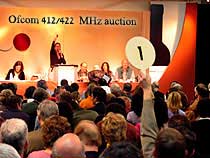 By way of an example, let's assume there are four bidders: Eric, Simon, Abby and Tamara. Eric offers GBP300,000 for all four blocks of spectrum. Simon wants 3 blocks and offers GBP200,000 for blocks A, B and C but is not interested in D. Abby wants only 1 block and offers GBP150,000 for any of them - A, B, C or D. Tamara wants two contiguous blocks and offers GBP250,000 for A&B, B&C or C&D. How do we decide the winner? Well in this situation, the maximum revenue that can be generated is if Simon gets blocks A, B and C and Tamara gets block D, yielding revenue of GBP350,000 for Ofcom. If, however, Tamara had only bid GBP100,000 for any block, there would have been a tie. Eric's offer of GBP300,000 for all 4 blocks would tie with a combination of Simon and Tamara's offers.
By way of an example, let's assume there are four bidders: Eric, Simon, Abby and Tamara. Eric offers GBP300,000 for all four blocks of spectrum. Simon wants 3 blocks and offers GBP200,000 for blocks A, B and C but is not interested in D. Abby wants only 1 block and offers GBP150,000 for any of them - A, B, C or D. Tamara wants two contiguous blocks and offers GBP250,000 for A&B, B&C or C&D. How do we decide the winner? Well in this situation, the maximum revenue that can be generated is if Simon gets blocks A, B and C and Tamara gets block D, yielding revenue of GBP350,000 for Ofcom. If, however, Tamara had only bid GBP100,000 for any block, there would have been a tie. Eric's offer of GBP300,000 for all 4 blocks would tie with a combination of Simon and Tamara's offers.The question was asked of Ofcom, "How will you decide between bidders in the event of a tie?" Ofcom's Director of Spectrum Markets, Graham Louth, a well-respected economist replied, "We have a Bingo machine". Highly complex calculations and then a Bingo machine, it's nice to know that UK Government departments use the latest technology, makes you much happier to pay all those juicy taxes.
Let's take a look at the spectrum on offer. In principle it's quite handy. Most modern UHF radios cover the range 400 to 470 MHz and could easily operate in this band. Further, this is one of the main bands in which digital TETRA radios are designed to operate. And if that's not enough, there are even CDMA networks designed to operate in this band. So there's no lack of available equipment. Ofcom are offering the spectrum on a technology neutral basis so any of these technologies could be deployed. Or could they...
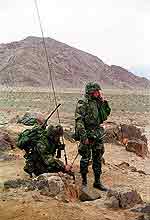 All is not quite as straightforward as it might at first seem. Remember I said earlier that the MoD have now largely vacated this band, well the fact is that there are still around 100 MoD frequency assignments (approximately half of them in Northern Ireland). Details of what and where these assignments are will be accessible to succesful bidders via a software tool that disguises the actual location of usage (for security reasons of course). Further, there are a handful of channels which are used, nationwide, by the MoD. Unless these assignments fall at the very edges of the band (unlikely), there would be insufficient spectrum to deploy cdma2000 which requires a clear block of about 1.5 MHz in order to function. When quizzed about this apparent contradiction to Ofcom's technology neutral stance, Graham Louth responded, "You are misconstruing what we mean by technology neutral". Is that so? cdma2000 can be deployed if you want to, but practically speaking it's impossible to do so. That's like saying, "You can cover this land I'm selling with a building as large as you like, however you mustn't disturb the herb gardens which I've scattered right across it. Oh, by the way, I'm not going to tell you where the herb gardens are until you buy the land".
All is not quite as straightforward as it might at first seem. Remember I said earlier that the MoD have now largely vacated this band, well the fact is that there are still around 100 MoD frequency assignments (approximately half of them in Northern Ireland). Details of what and where these assignments are will be accessible to succesful bidders via a software tool that disguises the actual location of usage (for security reasons of course). Further, there are a handful of channels which are used, nationwide, by the MoD. Unless these assignments fall at the very edges of the band (unlikely), there would be insufficient spectrum to deploy cdma2000 which requires a clear block of about 1.5 MHz in order to function. When quizzed about this apparent contradiction to Ofcom's technology neutral stance, Graham Louth responded, "You are misconstruing what we mean by technology neutral". Is that so? cdma2000 can be deployed if you want to, but practically speaking it's impossible to do so. That's like saying, "You can cover this land I'm selling with a building as large as you like, however you mustn't disturb the herb gardens which I've scattered right across it. Oh, by the way, I'm not going to tell you where the herb gardens are until you buy the land".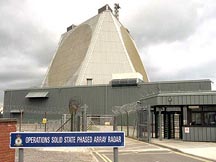 If that's not bad enough, the RAF Ballistic Missile Early Warning System (BMEWS) radar at Fylingdales in North Yorkshire uses the frequencies from 420 to 450 MHz and so the 422 - 424 MHz block can not be used within the vacinity of this station. The radar, which uses high powered radio transmissions to track incoming missiles, is also likely to cause severe interference over a wide swathe of Northern England. So now as well as the herb gardens, we've got industrial chimneys spewing out pollution over large areas of the land for sale. How come the chimneys don't already pollute the herb gardens, well they're owned by the same person of course - the MoD!
If that's not bad enough, the RAF Ballistic Missile Early Warning System (BMEWS) radar at Fylingdales in North Yorkshire uses the frequencies from 420 to 450 MHz and so the 422 - 424 MHz block can not be used within the vacinity of this station. The radar, which uses high powered radio transmissions to track incoming missiles, is also likely to cause severe interference over a wide swathe of Northern England. So now as well as the herb gardens, we've got industrial chimneys spewing out pollution over large areas of the land for sale. How come the chimneys don't already pollute the herb gardens, well they're owned by the same person of course - the MoD!Most likely someone will want to buy this spectrum; an auction for the same spectrum in the Republic of Ireland raised Euro215,007 for the Irish Government. However with so many holes and so much pollution in it, it will be interesting to see how much, or how little, the auction raises. I'll let you know.
Wednesday 15 February, 2006, 13:26 - Radio Randomness
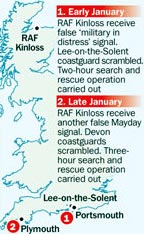 I read an article in The Times newspaper yesterday entitled 'Coastguard scrambled as set-top box sends SOS'. It would appear that, on two separate occasions, radio emissions from a Freeview set-top box had raised an alert with the coastguard who had sent search and rescue helicopters out to find the source, apparently costing GBP20,000 or so on each occasion (special 'centrifrugal' helicopter fuel is very expensive you see).
I read an article in The Times newspaper yesterday entitled 'Coastguard scrambled as set-top box sends SOS'. It would appear that, on two separate occasions, radio emissions from a Freeview set-top box had raised an alert with the coastguard who had sent search and rescue helicopters out to find the source, apparently costing GBP20,000 or so on each occasion (special 'centrifrugal' helicopter fuel is very expensive you see).The alert concerned was simply a transmission on a frequency of 121.5 MHz, one of the internationally recognised distress frequencies. Devices called Emergency Position-Indicating Rescue Beacons (EPIRBs) use this, and other frequencies (406.1 MHz for civil and 243.0 MHz for military emergencies) to alert an international network of Search and Rescue satellites (SAR-SATs) when a vessel is in distress. The various satellites which monitor this frequency can pin-point to within an accuracy of about 20km, the location of any transmission, over an area comprising about 60% of the surface of the earth. The unintentional radiation from the set-top box would therefore have triggered the satellites (which believed it was a distress beacon) to alert ground stations to the signal. The fact that the set-top box concerned was located in Plymouth, a busy naval town as opposed to in the middle of the English countryside would have further alarmed the coastguard (as boats in distress surrounded by miles of farmland would be rather suspicious).
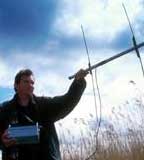 The story continues to say that officials tracked down the source of the interference and knocked, antennas in hand, on the door of the poor unsuspecting lady whose box was at fault. She clearly thought she had been tracked down for television licence evasion, though why she would think this if she had a licence is rather confusing. Obviously the signals were strong enough to merit intervention from the authorities, who took the action of tracking and closing down the problem rather than allowing it to continue.
The story continues to say that officials tracked down the source of the interference and knocked, antennas in hand, on the door of the poor unsuspecting lady whose box was at fault. She clearly thought she had been tracked down for television licence evasion, though why she would think this if she had a licence is rather confusing. Obviously the signals were strong enough to merit intervention from the authorities, who took the action of tracking and closing down the problem rather than allowing it to continue.Two things are surprising about this story. Firstly, the fact that the transmissions from the set-top box were strong enough to raise the alert with the satellite network. EPIRBs operating on 121.5 MHz typically use a power of 50mW or more. The malfunction of the set-top box must have caused some device within the box to oscillate and these oscillations were then radiated back through the TV antenna or the down-lead. To get a 50mW signal in such circumstances, however, is pretty good going. Even a well designed VHF oscillator would struggle to provide a stable 50mW of power on a fixed frequency without drifting as the oscillator got warmer or cooler. And given the poor performance of the antenna at these frequencies, it is likely that the power generated by the set-top box would need to be significantly more than this. It is no surprise that a ground-based search was also able to track down the signal!
 It is worrying in many ways that this is the case. Had the transmission been on a different frequency (for example 121.9 MHz) it would have interfered with air-traffic control (in this case at Heathrow airport). Such events do regularly occur, however there are no satellites that can pin-point the location of the transmission and many go unchecked.
It is worrying in many ways that this is the case. Had the transmission been on a different frequency (for example 121.9 MHz) it would have interfered with air-traffic control (in this case at Heathrow airport). Such events do regularly occur, however there are no satellites that can pin-point the location of the transmission and many go unchecked. The second thing which is surprising is that the box could produce such radiations in the first place. All electronic equipment has to conform to a set of standards known (in Europe) as the EMC directive. This requires all manufacturers to certify that their equipment does not suffer when in the presence of nearby radio transmissions AND that it does not cause unintentional radiation. The set-top box would have had to conform to this standard and thus should have been checked for emissions. Clearly, in this case, the set-top box was malfunctioning, which means that the tests conducted by manufacturers are not extensive enough to capture the results of fault conditions. Does that mean that I could produce a toaster which, if held upside down radiated a couple of Watts in the FM band and claim it conformed when used normally, to toast bread?
What's most worrying is that there are probably hundreds more cases of such radiation which go on unnoticed. In one respect the fact that they are unnoticed means that they are not causing anyone any problems. On the other, it does question whether opening up the use of the radio spectrum in a less controlled manner would really cause the mass devastation that many people seem to think it would.

